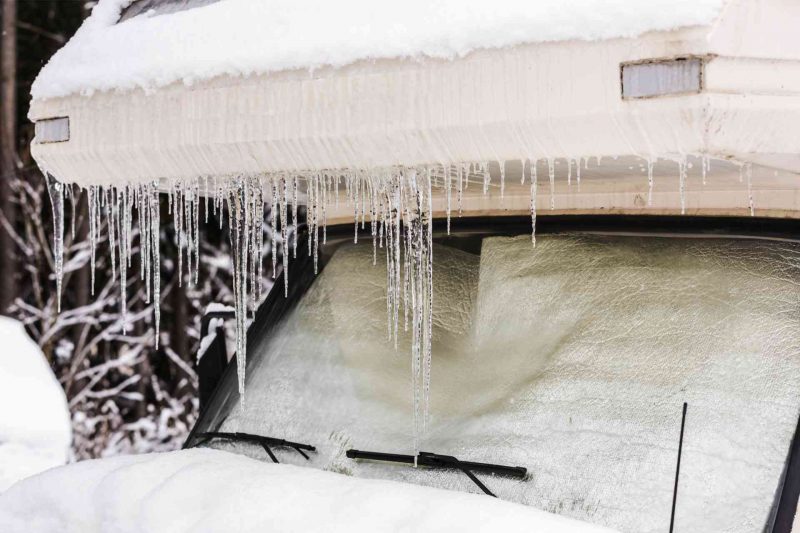While camping season is during the summer for most RV owners, some enjoy using their rigs year-round. Using an RV during the winter means keeping an eye on the forecast. Being in an RV when freezing temperatures are in the forecast is no picnic.
Because many campers typically lack sufficient insulation, experiencing frozen RV water lines isn’t uncommon. However, unfreezing these water lines can be challenging. Many RVers in these situations often wonder if you can thaw them. Well, let’s see.

How Do I Know If My RV Water Lines Are Frozen?
The outside temperature must be below freezing for your RV water lines to freeze, typically for several hours in most cases. If you’re experiencing issues with your RV water lines and the temperature hasn’t dipped below freezing, you’re likely dealing with an entirely different plumbing situation.
If your water lines are frozen, you’ll likely discover this when you try to flush a toilet or use a water faucet. However, just because you have some water lines freeze doesn’t mean all of them will.
You may discover that your kitchen or bathroom faucets freeze while others do not. Some water lines have shorter runs or are more insulated than others.
Will a Frozen RV Line Always Burst?
Just because you experience frozen water lines in your RV, doesn’t necessarily mean it will burst. Water lines will only do that if there’s no room in the line for the water to expand as it turns into ice. This can become a serious problem if you expect frigid temperatures.

Temperatures dipping into the low 20s overnight may not be cold enough to cause your lines to freeze. However, some of the most capable RVs can experience frozen RV lines when temperatures drop into the teens and single digits.
The longer and further the temperatures stay below zero, the greater the chances you’ll experience damage. You could experience cracks in fittings, or a water line could completely burst.
How Can I Thaw Frozen RV Water Lines?
If you are unfortunate enough to experience frozen RV water lines, there are some things you can try to thaw them. Aside from waiting for the sun to come out and do the work for you, here are your next best options.
Heat Tape Around Lines
One of the most effective ways for thawing your lines is to use heat tape around them. This will slowly heat them, which is the safest way to thaw them.
If you purchase heat tape with a thermostat, you won’t have to worry about causing damage to the pipes or lines in your system.
All you need to do is wrap the heat tape around the frozen line and plug it into an electrical outlet. The time it takes to thaw the frozen RV water line will depend on the amount of ice in the line. You may need to repeat this process in multiple spots throughout the water line or multiple lines.
Hair Dryer or Heat Gun
Sometimes all you need to thaw your frozen RV water lines is a hair dryer or heat gun. These devices can generate tremendous heat and quickly increase the temperature around the water lines to thaw the ice. Simply crank them up and shoot them toward the frozen water lines, and there’s a good chance you’ll have thawed pipes in no time.
However, because these devices can generate so much heat, you must be careful with them. You could cause more harm than good if you focus them too much in one spot or place them too close to the lines. You could melt plastic or ruin essential components of your RV. So make sure to be careful when using these on your rig.
Portable Propane Heater
Many RVers use portable propane heaters near their frozen water lines. These can produce a lot of heat and spread it over a broad area. Many RVers will place heaters under their rigs to help send warm air into the underbelly and thaw the water lines.
We want to remind you that portable propane or electric heaters can be extremely dangerous. You should never leave them running unattended or too close to flammable materials. A fire breaking out in your RV will thaw your water lines while you watch your precious RV go up in smoke.
Will Pouring Hot Water Down the Drain Unthaw Frozen Pipes?
Putting hot water down the drain will not unthaw your frozen water lines. The water line for the faucet and the drain go to separate areas. As a result, you’re doing nothing toward thawing your frozen RV.
To help you unthaw your frozen pipes, ensure your water heater is on and run some hot water. Sometimes hot water from the water heater can be enough to melt the ice in the faucet or water line.
If the temperatures are still below freezing, this is not likely a great option. However, it can expedite the thawing process once the temperatures are above freezing.
HOT TIP
Is It Safe to RV in the Snow?
Can I Just Wait for Pipes to Thaw on Their Own?
In many cases, once your RV water lines freeze, there’s not much you can do except wait. If the freezing temperatures are only for a day or two, you can get by with frozen water lines, especially if you’re in a campground with restroom facilities.

Once the sun comes out and warms things up, your pipes will slowly thaw themselves. This is a decent option, especially if you can get water or use the restroom in a bathroom facility and temperatures aren’t freezing.
How Long Does It Take for RV Pipes to Unfreeze?
The time it takes for RV pipes to unfreeze will depend on how much heat gets to them. Depending on the amount of water in the pipe, it can take minutes to hours for them to unthaw.
While you may be in a hurry to get water running through the pipes, the safest way to unfreeze them is a gradual process. Don’t rush the process and damage your plumbing system.
How Can I Prevent RV Water Lines From Freezing?
The best way to prevent RV water lines is to stay out of freezing temperatures. Many RVers head south to states like Florida, Texas, and Arizona for the winter. However, that doesn’t always guarantee that you will avoid freezing temperatures, and it’s not always possible for every RVer.
Installing skirting around the base of your RV can help prevent cold air from getting under your RV and causing your pipes to freeze. You want to trap as much warm air under your rig as possible.

If you have a four-season RV, it will likely have heat ducts in the underbelly. Anytime your propane furnace runs, it will pump warm air into the underbelly, which contains many water lines.
While frozen RV water lines can be a pain, it’s not always the end of the world. If you do all you can to protect them from the elements, you’ll decrease the chances of experiencing significant issues. However, you now know how to thaw frozen RV water lines if you experience them.
If You Want the Latest Travel News, Join Our Mailing List
Don’t rely on biased RV industry news sources to keep you informed. Stick with Nomadic News. We publish articles and breaking stories that matter to you every weekday.










